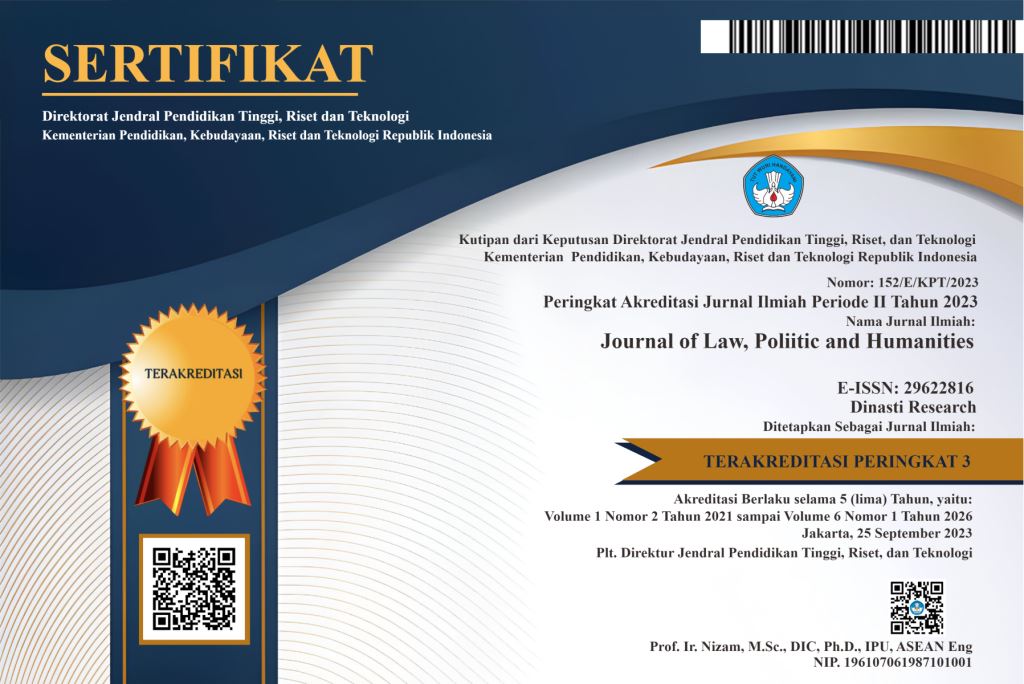Legal Aspects of Medical Waste Management in Health Care Facilities and Protection of Environmental Health
DOI:
https://doi.org/10.38035/jlph.v4i6.786Keywords:
Medical Waste, Regulation and Management of Medical Waste, Healthcare Facilities, Environmental HealthAbstract
Hazardous and Toxic Material Waste/ (Hazardous and Toxic Materials) is the residue of a business and/or activity that contains hazardous and toxic materials (B3). One of the B3 wastes is medical waste, which is infectious waste produced from activities in healthcare facilities, both in the form of solid and liquid waste. This medical waste is generated from activities such as hospitals, health centers, independent practice places, clinics, etc. facilities. Medical waste is an infectious object or item that must be managed properly, starting from the time of collection, and transportation, to the destruction process. Therefore, there needs to be legally binding regulations related to waste and its management. This research is descriptive and will produce an overview of B3 waste management regulations, especially medical waste with the protection of environmental health rights. The research approach used is a normative legal approach. The data collected is in the form of secondary data, while the analysis method used is qualitative. The results of the study show that the more human activities increase, the more waste is produced. Medical waste is one of the B3 wastes. Medical waste is waste that is directly generated from the diagnosis and treatment of patients in healthcare facilities, such as polyclinics, nursing, surgery, obstetrics, autopsies, and laboratory rooms. To avoid environmental risks, medical waste management must be done properly. Various laws and regulations for B3 waste management have been established, including Government Regulation Number 19 of 1994 (PP 19/1994) concerning Waste Management of Hazardous and Toxic Materials up to PP 101/2014. The provisions regarding B3 waste management are based on Law Number 32 of 2009 concerning Environmental Protection and Management (UUPLH). However, medical waste still needs to be synchronized with the provisions in Law Number 36 of 2009 concerning Health. Efforts to protect environmental health are carried out through the regulation and management of medical waste in healthcare facilities. Through the regulation and management of medical waste, it can prevent environmental pollution prevent the transmission of diseases (infections), and avoid the misuse of waste, so that it can maintain environmental health.
References
Amanah, I. N. (2022). Environmental Cost Accounting: Behind the Major Project for the Construction of a Covid-19 Hazardous Waste Management Facility. Jurnal Perencanaan Pembangunan: The Indonesian Journal of Development Planning, 6(2), 186–201. https://doi.org/10.36574/jpp.v6i2.336
Arlinda, V. P., Windraswara, R., & Azina, M. (2022). Analisis Pengelolaan Limbah Medis. JPPKMI: Jurnal Penelitian Dan Pengembangan Kesehatan Masyarakat Indonesia, 3(1), 52–61.
Creswell, J. W. (2019). Research design pendekatan kualitatif, kuantitatif, dan mixed (A. Fawaid & S. Z. Qudsy, Eds.; 5th ed., Vol. 3). Yayasan Mitra Netra.
Hartami, A., Karjoko, L., & Ulfatun Najicha, F. (2023). Optimalisasi Peran Pemerintah Dalam Kebijakan Penanganan Limbah Medis. PLEDOI (Jurnal Hukum Dan Keadilan), 2(1), 12–19. https://doi.org/10.56721/pledoi.v2i1.168
Hutajulu, S. M., Marsaulina, I., Siregar, F. A., & Indirawati, S. M. (2022). Solid Medical Waste Management Strategy in Hospitals, Indonesia. The Open Public Health Journal, 15(1). https://doi.org/10.2174/18749445-v15-e221223-2022-152
Janik-Karpinska, E., Brancaleoni, R., Niemcewicz, M., Wojtas, W., Foco, M., Podogrocki, M., & Bijak, M. (2023). Healthcare Waste—A Serious Problem for Global Health. Healthcare, 11(2), 242. https://doi.org/10.3390/healthcare11020242
Larasati, A., Riogilang, H., & Riogilang, H. (2022). Evaluasi Pengelolaan Limbah Medis Bahan Berbahaya dan Beracun (B3) di RSUP Prof. Dr. R. D. Kandou Manado. TEKNO, 20(82), 1021–1030.
Masruddin, Yulianto, B., Mulasari, S. A., & Sari, S. I. (2021). Pengelolaan Limbah B3 Fasilitas Pelayanan Kesehatan (Medis Padat) Di Puskesmas X. PREPOTIF: Jurnal Kesehatan Masyarakat, 5(1), 378–386.
Nursamsi, N., Thamrin, T., & Efizon, D. (2017). Analisis Pengelolaan Limbah Medis Padat Puskesmas Di Kabupaten Siak. Dinamika Lingkungan Indonesia, 4(2), 86. https://doi.org/10.31258/dli.4.2.p.86-98
Ontran Sumantri Riyanto, Adi Purnomo, Yohana Kristiyaning Rahayu, & Arif Wahyudi. (2021). Medical Waste Management: The Need For Effective Regulation of The Minister of Environment And Forestry In Indonesia. International Journal of Science, Technology & Management, 2(1), 281–288. https://doi.org/10.46729/ijstm.v2i1.122
Pratiwi, D., & Maharani, C. (2013). Pengelolaan Limbah Medis Padat Pada Puskesmas Kabupaten Pati. KESMAS: Jurnal Kesehatan Masyarakat, 9(1), 74–84.
Shareefdeen, Z. M. (2012). Medical Waste Management and Control. Journal of Environmental Protection, 03(12), 1625–1628. https://doi.org/10.4236/jep.2012.312179
Sugiyono. (2021). Metode Penelitian Kuantitatif, Kualitatif, dan R&D. Alfabeta.
Tolba, M. K. (1990). The global agenda and the hazardous wastes challenge. Marine Policy, 14(3), 205–209. https://doi.org/10.1016/0308-597X(90)90074-2
Yustina, E. W. (2021). Aspek Hukum Pengelolaan limbah Medis pada Fasilitas Pelayanan Kesehatan dan Perlindungan Terhadap Kesehatan Lingkungan. Jurnal Paradigma Hukum Pembangunan, 6(1), 98–115. https://doi.org/10.25170/paradigma.v6i1.2585
Downloads
Published
How to Cite
Issue
Section
License
Copyright (c) 2024 Siti Nurhayati, Noviati Sri Racha

This work is licensed under a Creative Commons Attribution 4.0 International License.
Authors who publish their manuscripts in this journal agree to the following conditions:
- The copyright on each article belongs to the author(s).
- The author acknowledges that the Journal of Law, Poliitic and Humanities (JLPH) has the right to be the first to publish with a Creative Commons Attribution 4.0 International license (Attribution 4.0 International (CC BY 4.0).
- Authors can submit articles separately, arrange for the non-exclusive distribution of manuscripts that have been published in this journal into other versions (e.g., sent to the author's institutional repository, publication into books, etc.), by acknowledging that the manuscript has been published for the first time in the Journal of Law, Poliitic and Humanities (JLPH).


























